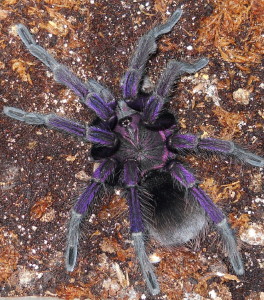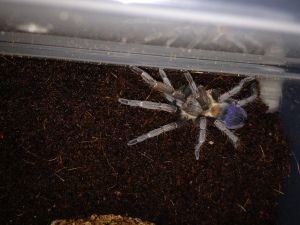Giant Blue Bloom Tarantula (Pamphobeteus nigricolor)
Care Sheet, New World, Pamphobeteus No Comments »The Giant Blue Bloom tarantula or Blue Bloom Birdeater is a species found in or around Bolivia, Peru, Ecuador and neighboring countries around the South-West coastline of South America. They grow to be about 7 inches in length with females growing slightly bigger then males They grow like weeds and get prettier as they get bigger. As slings (spiderlings) they have an orange abdomen with black patterns resembling a conifer/pine tree. As adults they display sexual dimorphism where not only are males smaller but also end up having superb color patterns ranging anywhere from a purple carapace to purple/blue/black legs while females tend to be more velvet black in color with pink colored hairs and pink markings on their carapace.
Habitat:
The Giant Blue Bloom Tarantula are terrestrials but as slings and juveniles they might burrow. We recommend a 5 to 10 gallon enclosure depending on the size of your tarantula filling at least half with slightly moist substrate. We use coconut fiber for ours and it seems to do the trick just fine. Your humidity should range from 70% to 85% with plenty of ventilation and a temperature of 70 to 75 degrees Fahrenheit. This species we’ve noticed becomes a tad bit nervous if the temperature is a bit too high. As always a fresh water dish should always be readily available and on the opposite side of the hide in the enclosure.
Feeding:
The Blue Bloom are voracious eaters. As slings we feed them flightless fruit flies to small pinhead crickets. Fully grown they can eat up to 3 times a week with ease. Juveniles to Adults should have a steady diet of B.dubia roaches, crickets and locusts. This tarantula jumps sometimes when catching its prey. We do not recommend over feeding your tarantula and you should always keep a close eye on it and its prey. Any prey left in its enclosure uneaten after 48 hours should be removed just in case your tarantula is in pre-molt stages.
Attitude:
The Giant Blue Bloom Tarantula tends to flee when strongly disturbed but can be pretty defensive. It comes equipped with urticating hairs and an unpleasant bite. Their venom though strong is harmless to humans. Handling is possible but we strongly recommend you not to.
All in all it is a very nice looking tarantula that’s almost always visible. We recommend this species for someone who already has some experience with tarantulas.


